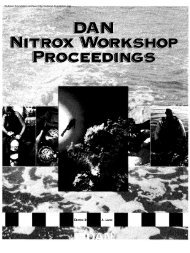dan avoiding ear & sinus injuries in scuba - Divers Alert Network
dan avoiding ear & sinus injuries in scuba - Divers Alert Network
dan avoiding ear & sinus injuries in scuba - Divers Alert Network
You also want an ePaper? Increase the reach of your titles
YUMPU automatically turns print PDFs into web optimized ePapers that Google loves.
THE UPS AND DOWNS OF DIVING.<br />
STUDENTS<br />
GUIDE<br />
DAN AVOIDING EAR & SINUS INJURIES IN SCUBA DIVING<br />
HOW TO EQUALIZE<br />
The ma<strong>in</strong> th<strong>in</strong>g to remember is to beg<strong>in</strong> to equalize <strong>ear</strong>ly; start on the surface with<br />
a gentle Valsalva maneuver. At the first h<strong>in</strong>t of a problem the descent should be<br />
stopped until you have equalized. If equalization is not possible, it may be helpful<br />
to ascend to a shallower depth and reattempt the process us<strong>in</strong>g a slower approach<br />
or a different technique. Equalization becomes more difficult as the pressure<br />
gradient between the middle <strong>ear</strong> and the environment <strong>in</strong>creases. Gentle, frequent<br />
equalizations are more effective and less likely to cause damage than forceful<br />
equalization, especially after significant pa<strong>in</strong> has occurred.<br />
THE VALSALVA MANEUVER<br />
In probably the most commonly taught method, the diver closes the mouth,<br />
p<strong>in</strong>ches the nose and blows gently.<br />
Avoid blow<strong>in</strong>g too hard and over<strong>in</strong>flat<strong>in</strong>g the middle <strong>ear</strong> space. This can occur if<br />
the diver is overly excited or hav<strong>in</strong>g a difficult time equaliz<strong>in</strong>g dur<strong>in</strong>g descent, and<br />
especially if he has waited too long before attempt<strong>in</strong>g to equalize. The result could<br />
be <strong>in</strong>jury to the middle or <strong>in</strong>ner <strong>ear</strong>.<br />
THE FRENZEL MANEUVER<br />
This method is similar to the Valsalva maneuver, except that <strong>in</strong>stead of blow<strong>in</strong>g<br />
air <strong>in</strong>to the <strong>s<strong>in</strong>us</strong>es, the diver closes the nose and mouth and drives the tongue<br />
backward on the roof of the mouth. The muscle contraction opens the nasal<br />
cavities and Eustachian tube, which allows air <strong>in</strong>to the middle <strong>ear</strong>.<br />
THE YAWN & SWALLOW MANEUVER<br />
Some divers can simply swallow, yawn or thrust the lower jaw forward and open<br />
the mouth while us<strong>in</strong>g the lips to ma<strong>in</strong>ta<strong>in</strong> a seal with the regulator mouthpiece.<br />
This opens the Eustachian tube to the middle <strong>ear</strong>, which equalizes pressure.<br />
As long as the <strong>s<strong>in</strong>us</strong>es also equalize easily, this maneuver is acceptable.<br />
For many divers, a comb<strong>in</strong>ation of these methods — even switch<strong>in</strong>g back and forth<br />
dur<strong>in</strong>g a s<strong>in</strong>gle descent — works best. S<strong>in</strong>ce the ostia, or open<strong>in</strong>gs, to the <strong>s<strong>in</strong>us</strong>es<br />
are normally open cont<strong>in</strong>uously, <strong>s<strong>in</strong>us</strong> equalization normally does not require any<br />
special maneuvers. Pa<strong>in</strong> <strong>in</strong> the forehead or cheek dur<strong>in</strong>g descent usually <strong>in</strong>dicates<br />
that there is some obstruction <strong>in</strong> the <strong>s<strong>in</strong>us</strong> ostium, and the dive should be aborted.<br />
2<br />
www.<strong>dan</strong>ismybuddy.com

















